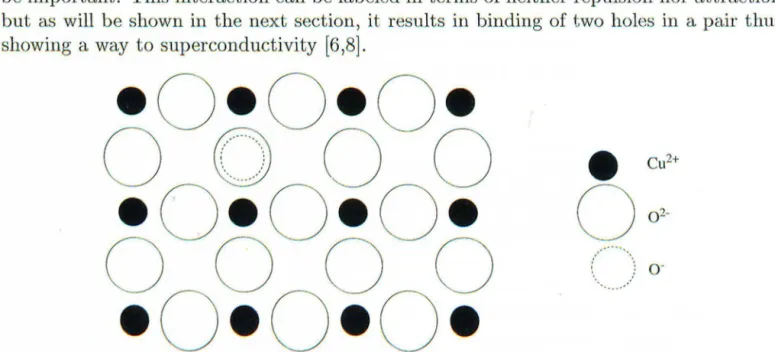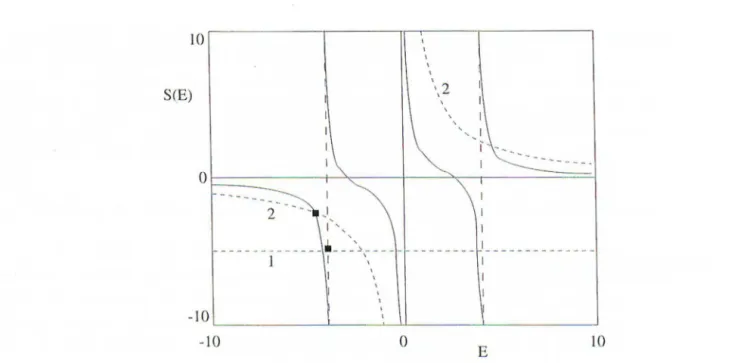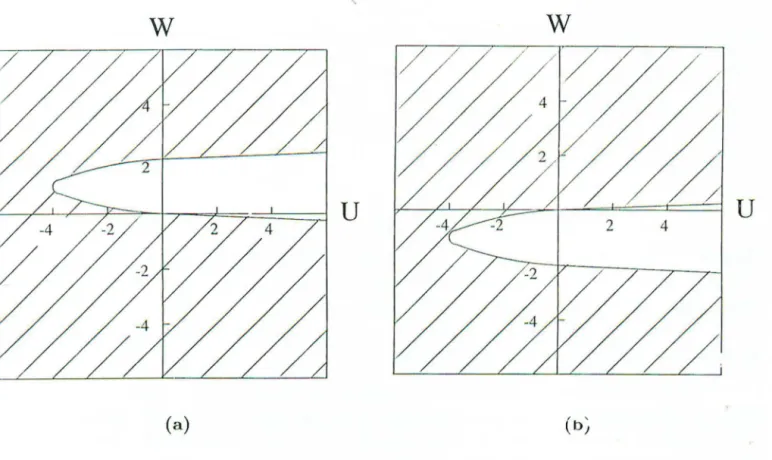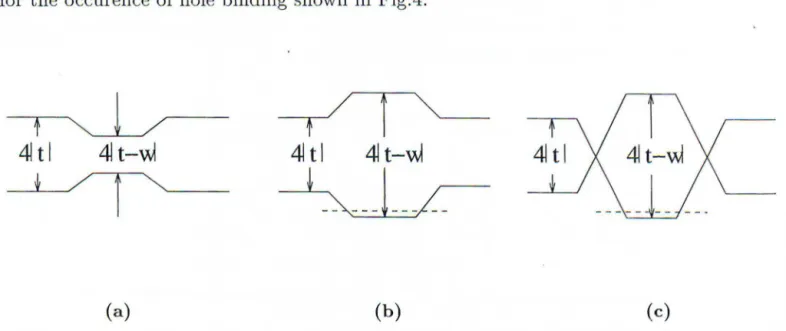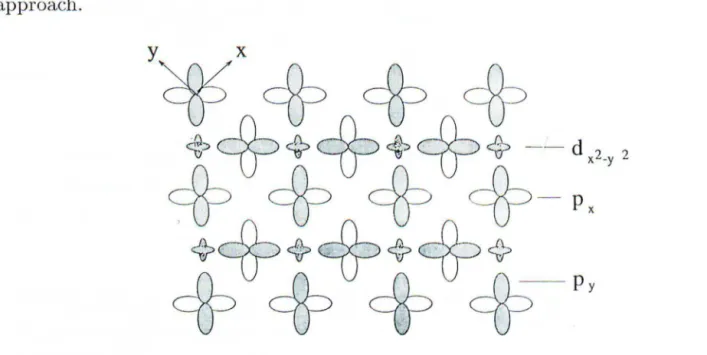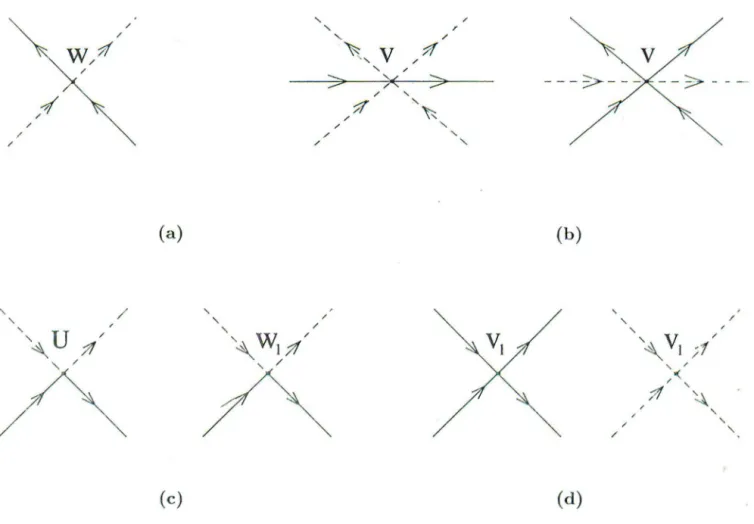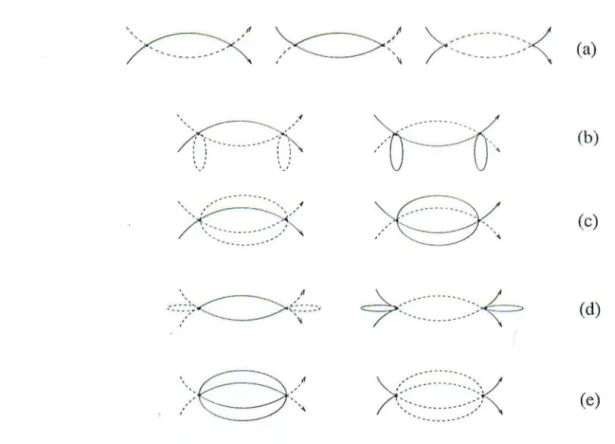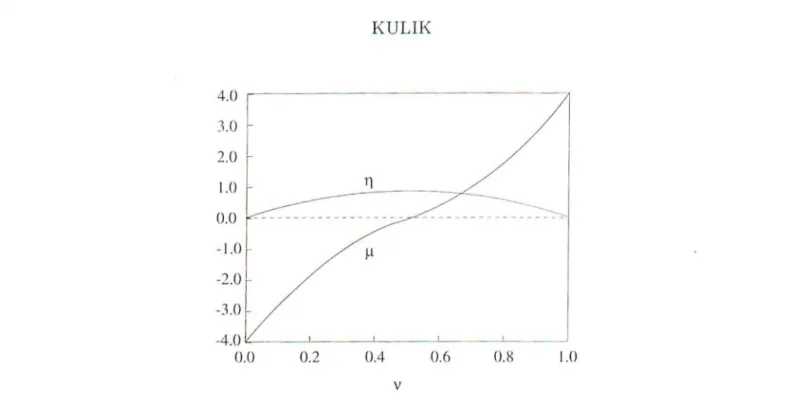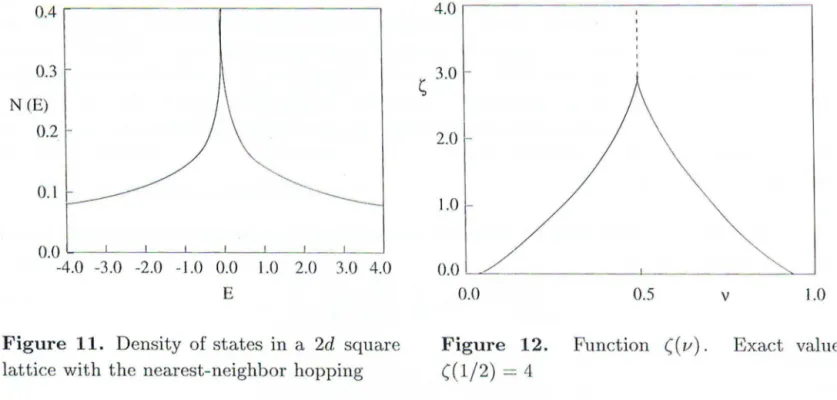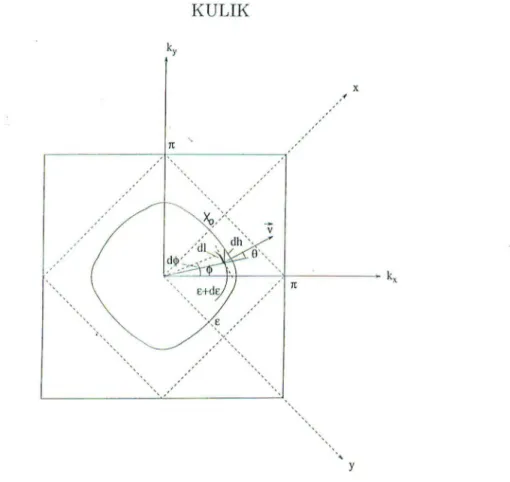Cont
rac
ti
on
of Atomic O
r
bit
a
l
s
in th
e
Oxyg
e
n Anion
'Netwo
rk a
nd
S
uperco
n
ductivity in Metal Oxide
Compounds
I. 0. KULIK*DepaTtment of Physics, Bilkent University, Bilkent 06533, Ankara-TURKEY
Rec iv d 17.5.1996 Abstract
Anion network in the C7./,02 plane of m tal-oxid compound is consid red as an intrinsic-hole m 'tal with hol·s rath r than 'le trans ·omprisiu )' a Penni liq -uid immersed in th background of n gative 0 2- ions. Due to th ontrac-tion of p-orbital of oxygen as a result of occupation by a hole, hole hopping b e-twe n n ~arest neighbor sites ( i, j) is d ,p ndent npo.n hol' o · upation as ti.i,a-
=
t;0 Vn,;,-17ni,-u+
H!(ni,-u ni,-u) . 'ouplillg pararnetersv
V
and V (ad litiv and multiplicative "contraction interaction" tenm>) result in the binding of holes into singl t, on-sit configuration, r into tripl t, n ar st-n ighbor-sitc onfiguration, du to vV and V respectiv >]y. In th w 'ak coupling limit, HI results in th I3 typ of supercondu tive pairing (singlet, s-wave), wh r 'as multipli ativ contra tion V provides for either singlet, d-w<w or tri] l t, p-ww '-lih pairing stat s. Tt is 'on -eluded that the latter stat m· y r sult in a plausibl' m chanism for high-Tr: sup 'r -conductivity in metal oxid' ompounds. The supcrcond11cting p-phas-' i.· sh wn to be in accord with recently published ymmetry t sts of th order parameter in oxid s.1. Introduction
Sine th discovery of high-temp rature sup rcon lu bvity in La2_xBa1; u04(1] and Y Ba20u30t>+x[2], great efforts hav" b en devoted to the experimental 'tudy of physi al prop rti -'S of high-
Tc
super onductors and th ir "xt "nsion to n-w materials as W"ll as to the tlPoretica,l i11v sUg·:~.tion of th'-' ha i physi ·al nP h· nisms of a n w Sll -perconducting stat . on erning the latter, several racli al ·hanges in Lh stH.t '-of-·:~.rt of ·oud nsed matt r theory llav b-"11 ·:ttt mpted. Nou-f 'rmi-liquid s ua.rio of ·ondu · -tivity hav ' b -'11 suggest d and nontraditional quasiparti le statisti · · hara t "risti · of two-dim nsion·:tl syst ms have be n propos d; mom 'ntum pairing as w ll a· local pair -ing mechanisms of 1 osonizaLion have b- n investigat 'd; uon- 1 ctron-plwnon as w·"n aselectron-phonon mechanisms of attraction between electrons has been discussed; strongly correlated electron models have been considered.
Experimental study of new superconductors does not give a clue to theory as it does not reveal the novel features of high-
'l
"'c
superconducting state. All effects known for low-Tc superconductors (1\!Ieissner effect, the Abrikosov mixed state, flux quantization, Josephson effect, etc.) also exist in th oxide superconductors. The anomalous (almost vanishing) isotope effect in most-high-Tc materials (3] suggests that electron-phonon interaction may be not a unique mechanism of superconducting pairing.Investigation of an issue as to which components of an intermetallic compound, e.g., Y BaCuO (the rare-earth elements ? copper ions ? oxygens ?) are most r el-evant to superconducting properties, indicates that oxygen is probably a key element since according to high-energy X -ray and electron scattering data (4,5], a Fermi-liquid unambiguously related to oxygen-derived electronic states develops in the same range of a dopant (barium, oxygen, etc.) concentration at which the metallic conductivity and superconductivity sets in.
The fact that oxygen has an almost filled p-shell configuration suggests that holes in a p6 shell may play a similar role for the conduction in the oxides as do electrons originating from the almost empty atomic shells, in conventional metals. In the present paper, we shall follow this line of thought and will try to show that this "chemical" as -pect of high-Tc materials may result in a new type of band conduction and quasiparticle interaction which seemingly show the possibility for high-Tc superconductivity.
Section 2 describes the idea of the intrinsic-hole metal, as opposed to the conven -tional "intrinsic-electron" metals and introduces a new type of hole interaction termed the "contraction interaction" [6,7]. Sections 3 and 4 show, in methodical manner, the physical origin of the contraction interaction effect on quasiparticle pairing. Sections 5 through 7 analyze a weak-coupling regime of contraction interaction. It is suggested that the triplet, odd orbital-symmetry (p-wave) gapless state is the most probable scenario for superconducting behavior in the new high-Tc materials. This state is shown to be in accord with recent symmetry tests of the ord r parameter in oxides.
2. The Intrinsic-Hole Metal
In th investigation of unusual electronic properties of metal-oxide compounds, it was proposed [6,7] that the new features in the electronic band conduction should 1 e included. The first possibility is that intrinsic-hole rather than intrinsic-elect.rou carriers may be dominant charge carriers. The second is that, assuming "intrinsic-holes" are at work, the one-particle picture of the electronic transport is not fully adequate, because the hopping of holes in itself is nonconstant and is strongly dependent upon sit"' occupation. In conventional metals like N a, the Fermi surface is formed by electrons removed from metallic atoms leaving behind the closed-shell cation network ( N a+ ) . For the atoms
with almost filled atomic shells ( 0 b tween those), anion con.figunl.LiOlt 0 2 1s 'XP 'cL 'cl t.o est.abhsh with holes, rather than clcct.r ns, conclcm;ing t.o a hmni liqnicl in Lh' spac' betwe 'll anicms. [Notice that this has nothing to do with the el' ·tron-lik' or hole-like carriers as evide11ced hy the Hall effect. Th' cli1fercnc' betwe 'll 'intrinsic-electron" ancl
"inL ri11sic-hol " Lyp -' metals is Hlustrat 'd in Figure
l
].
CD
G 0
G 0
0
8
8
0
+ + + I· +CD
0
CD
CD
0
8
8
G
8
8
I· + + ·I (a) (b)Figure 1. Cation network with the intrinsic le trons condensing to a I· rmi licptid (a) and th anion network with intrinsic holes as a Fermi liqui I of positiv charge (1 ). Noti e that this
does not con ern with the sign of th Hall o ffi i 11t which in principl ca.n b ' both positiv a.n 'I n gative in 'ith "r case
N nnally, for oxygen at.ou1s Lhis do s not bapp n h cause two oxy ·ens have a stro11g t nd ncy Lo cov·:tl nt bonding resulting in the formaL ion of oxyg n mol" ul , 02 . How ver, in a proper hemical surrounding this ma.r not take pla ·c if th'-' n 'ar 'St n ighbor atoms ar" not too close to each oth r. Th n the oLh 'r s · 'nario will apply, rclllillis cut of rn tallic oxyg 'H. We may sup] os' that. this is just what happens in th' m "tal-oxid'
superconductors. In th' 'uO;. plane of the laLL ..:~r, chi-' Lo lcugc iollic radius of opp 'r
oxygen or hi ta.ls ar overlapping amm1gst. Lhems lvcs almos as strongly as Lh -' n a.r-si t oxyg n aud copper orl it':ds ( · •ig.2 in which oxyge11 '1JH.l ·op} 'r radii ar' shown
ap-proximately in scale). Then, th" 02 mol cul 'S a.re not formed, a.nc.l Lh' hol 'S d -'riv 'd from the p6 shells are to be the itinerant carriers. D
1 to ovcrla.pping of hol wave function:
at diifereut ions, hole can propagate from the oxygen anion to the u aresL on'.
Intrinsi hol s are not totally equivalent Lo the intrinsic 'l 'drons in Lh" seus Lhat LlPy can not b" fully r"'mov d from the par 'nt atom. But the -'xt 'mal atoms, like those in th' ligand plane of copp 'r-oxyg n ·hains can provide a prop 'r surromHlin · in wbi ·h Lhe hol may r 'sid ha.rg tra.nsf 'r hetwe 'H hol-s ·lt anions Ai, Aj in Lh' 'H02 pla.uc,
(Ai
+
hol ), AJ ·(A,;+
hole),(
l)
dcp 1clent upon dist· 11 · b tw' n th j ns (a is the ff ctivo anion radius)
{2)
If another hole (a hole with the anti parallel spin) is localized at the same anion, the anion radius will shrink as shown schematically by dotted line in Fig.2, thus changing the valueof tij . From the known data concerning oxygen and oxygen ion radii
(9],
o:
a = o.7.A,o
2- : a = 1.36.A (3)we conclude that this effect may be quite strong, i.e. the,."contraction interaction"
(7]
representing the change in the hopping amplitude upon hole localization is expected to be important. This interaction can be labeled in terms of neither repulsion nor attraction but as will be shown in the next section, it results in binding of two holes in a pair thus showing a way to superconductivity
(6,8].
•
0
•
0
•
0
•
0 0 0 0
•
0
•
0
•
0
•
0000000
• • • •
e
0
~ ... '. ' : Cu2
+o
2
-o
-Figure 2. Atomic configuration in the Cu02 plane of Y BCO and similar metal-oxide compounds. Full line, 0 2- configuration; dotted line,
o
-
configuration corresponding to ahole nesting at the oxyg n site. Contraction of the ion orbital due to extra. positive charge of th"
ion cor changes th hole h pping amplitud' b ·tween t.hi · anion and the nearest neighbor anion
It was proposed that hopping amplitude is dependent upon site occupation accord -ing to
[10)
tij,u = to(l - ni,-u )(1 - nj,-u)+
t1 [(1 - ni,-u )nj,-u+ n
i,-u(1 - nj,-u )]+
where niu (annihilati n) In case transitions: t2ni,-unj,-u, (4)
a
t
a
iu
is particle number operator, anda
ia
(
aiu) is crea.tion perator of hole with spin projection a- at site i.of oxygen anions, quantities to, t1, and t2 are the amplitudes of the
We expect that, due to the R-dependence of tij of the type represented by Eq.(2),
1;1 will be smaller than
to,
and t2 smaller than t1 and can be estimated as(6)
where S is the ratio of the distance between the maximum of the lattice potential
(presumably,. at the Cu2+ location) and the anion position.
Occupation dependence of the hopping can also be represented in another form,
(7) where, from ( 4),
(8)
If we accept the estimate for the hopping amplitude (6), the contraction parameters
V and vV will become
(9)
From this formula we conclude that the sign of V is expected to be opposite to the sign
of the unperturbed hopping amplitude
t,
whereas W should have the same sign as thatof
t
.
This will have an important implication for the appearance of superconductivity inthe corresponding regimes.
Including both type of contraction interaction, and also the Hubbard in-site
repul-sion, Hamiltonian of the system becomes
with
H =
-t
L
ata.aja+
Hu+
Hv+
Hw<ij>,a
Iiv
=
VL
ata.ajani,-anj,- a, <ij>,a Hw = WL
ata.aja(ni,- a+
nj,-a.). <ij>,a (10) (11)(12)
(13)The effect of a coupling term W in (10) has been considered in much detail in the
paper of Hirsch and Marsiglio [13], as well as in the author's papers [6,7,10]. Below, we
consider the effect of both types of contraction pairing. In the weak coupling regime, the
sign of W derived from (9) is unfavorable for superconductivity whereas the sign of V
is. Moreover, pairing due to V is not subject to a suppression by the intersite Coulomb
Models with different signs of
t
are in fact equivalent [11]. Change of the signof t can be compensated by the momentum transformation kx - } kx:
+
1r, ky ~ky
+
1r corresponding to the shift of the elementary cell, and therefore of the Fermisurface, in the reciprocal lattice by a vector ( 1r,
1r).
If not stated otherwise, later weshall consider t in (7) as positive. Then, according to previous consideration, coupling
parameter V is most likely expected to be negative whereas W a positive quantity.
3. Binding of Holes into Pairs via Contraction Mechanism (Singlet State)
To clarify the contraction mechanism of superconductivity, we consider in this
section a simple problem of two holes in an empty one-dimensional host lattice interacting
with one another via the occupation dependent hopping (13) and show that they bind
into a singlet pair similar to a Cooper pair, at appropriate sign of the interaction term
W . In the following section, we address the same problem of hole binding to a triplet
state due to the contraction energy V . The reader who is already familiar with the
pairing property of the interaction (7) may continue directly from Sect.5 which deals with
superconductivity in a dense 2d Fermi liquid of holes.
The 1d version of interacting holes in an anion network is represented by the Hamil
-tonian including the contraction interaction (7) and the Hubbard term U accounting for
the Coulomb interaction between holes at the same site
N N
H
-t
L
at.ai+l,a+
h.c.+
UL
nilnil+
i=l,a N
L
at.ai+l,a[Vni,- ani+l,-a+
W(n1.,- a+
ni+l,- a )]+
h.c. (14)i=l,a
Two holes in the noninteracting lattice ( U = V = W = 0) have an energy
€k = 2 COS k,
(15)
where k;
=
'tJ
n ( n is an integer) is the momentum of a finite-size, cyclic-boundary-condition anion chain of length N. Consider solution to the Schrodinger equation H'I!
=
E'I! in the form(16)
where X1, x2 are integers. Changing from the coordinate representation
f (
x1 , x2 ) to theFourier representation fk1k2 according to
f(xl,x2) =
L
fklk2ei(ktxl+k2x:2),kl ,k2
we obtain an equabon for the wave function amplitude /h:,k.:'!.
-[
/
;
(
c-
h
~,
+
C
h
~·
J
+
E
]h
~lk'2
+
~
L
.h,- k,k'2+A:+
'"
'vv
NL
fk,
-
h
:
)
:
2
+
d
c-
h~
1
+
Ek.:'!.+
E
k.
~
1
-
h:
+
Ek2+k:) =0.
h:By introducing the functions
where
Q
= kL+
k2 is a total momentum of a. pair, we obtain a solution[
U + vV(
c-h~1+
Ek2)]Fo
+
l
tV
FJ
t(ck1+
cX:2)+
Ewhich, after substitution back to Eq.(18), results in the equation for E
Ut2
+
W(W- 2t)E S(E),where S(E) is the function
S(E) 1 1 N
~
E+
t(cx:+
EQ- h:) · (18) (19) (20) (21) (22)The function S(E) is shown in Figure 3. By intersecting S(E) with the left hand side of Eq.(21) we obtain the eigenvalues E related to the energies of the propagating states (11), and an addibonal energy below the edge of noninteracting holes E
<
- 4I
t
I
10 S(E) -10 2 ' '. \ 2 \ \ I 1'' I ' - --- ---•-- -\ --- --- --- I_--- --- -I I \ I L---~--~~---~--- ----10 0 E 10
Figure 3. Function S(E) for N
=
4, Q=
0 (full line). Dotted lines - left-hand-side of Eq.(21)for W
=
0, U<
0 (a), and for U=
0, W<
0 (b). Squares indir::ate bound statesIn case of zero contraction and large negative Hubbard's U, the bound state energy
lS
u
<
o,
I
u
1
>>
1
t
I
(23) which corresponds to the binding energy -I
UI
and an effective mass of a pairm* = 1
u
1 /4t2 (24)much greater than the single particle effective mass m = 1/(2
I
t \) (in the unitsn
= a = 1, wh re t~ is Planck constant and a is the intersite spacing).In case of zero U and large W , Eq. ( 21) gives the energy of the bound hole- hole
state
Eb
=
-
I
w I
(25)2(1 +cos Q) .
corresponding to the value of the binding energy at Q = 0 Eb = -
I
WI
/4, and an effective mass8
.l'vf* = - -
(26)
\WI
which is negative and much smaller in the magnitude than the free hole mass. Therefore we obtain in this limit highly mobile bosons coupled to an energy -
I
WI
/4.At small
I
WI,
the symmetry between the positive and negative values of th'"' contraction energy W is removed and pairing is produced in a restricted range of couplings W. The phase diagram in the (U, W) plane showing the effect of pairing is presentedin Fig.4. We consider here both cases of positive and negative /; to show that the sign
of W corresponding to pairing correlates with the sign of t; in a manner opposite to the
one expected for "normal" contra.ction, Eq.(9) (decrease of hopping amplitude with more
localized holes, i.e. with extra positive charge on the anion).
w
w
u
4~
u
(a)
Figure 4. Phase diagram of hole binding into a singlet pair. Hatched region corresponds
t binding, empty one to no binding. U is the Hubbard energy, Hf the contraction energy.
(a) t
=
1; (b) t=
- 1However, it should be mentioned that this does not n cessarily exclude the pos
-sibility of superconductivity due to contraction mechanism in the copper-oxide system, since, owing to the anisotropic nature of p-orbitals and to the possibility of reorientation of those from the direction Cu - 0 to the direction 0 - 0 at increasing filling, the "renormalized" W value can be of any sign and magnitude (in particular,
I
vV1
>
1
tI).
The issue of the first-principle calculation of vV has been address ,din the Hirsch's paper
[14].
The origin of the pairing property within the contraction model can be explained as follows. Occupation dependence of hopping, Eq.(7), can be visualized as band narrowing (Fig.5,a) or widening (Fig.5,b), depending on the sign of vV, near the location of spin-clown hole. If signs of t; and W are opposite to each other, an effective potential barrier
is formed near the point at which the hole is located, thus repelling the other hole. In the opposite case when t; and HI are of the same sign, the potential well will be created near
as a trap for another hole irrespective of the sign of W. This explains the phase diagram
for the occurence of hole binding shown in Fig.4.
t
""
j
/
t
/
1
~
4hl
4h-w
41 t
I
41t-w
i
/
i
""
t
-~
-
-J
_
_;
_
(a) (b) (c)Figure 5. Formation of the quantum barrier near a hole for sign(W)
= sign(t)
(a), quantumwell at sign(W) = - sign(t) (b), and the band inversion at I W I> 2 It I (c). Dotted line
shows an energy of the bound state near the hole
4. Binding of Holes into Triplet State
Contraction term V proves to be inoperative in case of two holes with opposite
spins in an empty host lattice as this term does not appear in Eq.(18) following from (14). However we may expect on the basis of Fig.5 that two holes with the same spin located at a nearest sites will create an effective potential well, if sign( V) = sign( t), and
therefore acting as a trap for the third hole having opposite spin. To verify whether this
is the case we consider an eigenstate
\lf =
L
j(x1, x2I
x)a;;da;2la;1I
0>
(27)X1:l:2x
of the Hamiltonian with the interaction V alone,
N N
i=l,O" i=l,O"
The wavefunction amplitude f(x1,x2 I x) is expected to be antisymmetric in x 1,:x:2 and satisfies the equation
-
t
L[f(x1+
6,:x:2lx)
+
j(x1,x2+ 61
x)
+
j(x1,x2I
x+b)]+
6
VL(6xlxbx2,xl+t5
+6
:r;2:c
b
xl,x2+ti
)J(xl,x21
x
+
6)
= Ej(xl,x21x),
(29)where 8 = ±1 is the nuit vector connecting nearest neighbor sites.
Consider solntion to .Eq.(29) with a fixed moment11m Q
r
(
T T· J :-~·) = F(-~:· _ '1: ,1 .. _ x)eiQ(:1:, +:c:d-:1:). .·'I , ··' 2 ·' .. 1 · , · '2 · - · (30)
Aft cr expanJiug F(:1; 1, ~t2) in a Fomiu series analogous to (17) we shall obtain an
eqnation l'or the pairing amplitnde
h
.
:
,
f..:20, (31)
with Fo
=
F(O, - 8)=
- F( - b, 0).Substitution of Fh:rk:2 in to Eq.(29) gives an equation for F11
F{j = v L:sh{j'F{j' (32) b' where _ 1_ """"' (eik1ti _ ei.k'26)(eih:16' _ eik'26')eiQt/ Soo' = 2 L...t ·( ) . 2N "~1/;;2
t
C/,;J+Q+
Cf..:'2+Q+
Cf.,;l+h:'2- Q+
E (33)Choosing the total momentum of a bound state Q = 0, the eigenvalue equation
will be (34) 5 = _ _ 1_ """"' (sin k1 - sin k2 ) 2 - N 2 L...t 2t( cos k 1
+
cos k2+
cos( k L+
k2))+
E · /;: l f.,;2(35)
At large V , the energy of the bound state eqnals Eh =-
J
VJ
,
I
v
1
>>
1
t J. (36)We will not consider the problem of binding in mor ' detail since it serves only to provide some indication as to what may happen in a system composing of many holes. The strong coupling regime of the Hamiltonian (14) requires the numerical analysis [12].
5. The Cooper Instability
Contraction interaction::; in the anion network - terms (12), (13) iu the Harniltonian - result in the instability of the ground state of a fermi-liquid with respect to pairing of electrons in the zero-momentum state ( p, - p ). Spin structure of the paired state is however more complicated than in a standard BCS theory.
Consider first the weak coupling limit of an "additive contraction,, Eq.(13). Iu the
momentum representation, Hamiltonian Hvv reads
where
cp = ~ e-;,ps.
s
s is a vector between a given site and its nearest neighbor.
Singular part of the interaction (37) corresponds to krms with PI P2
=
- p':(37)
(38)
- p and
(39)
According to the Green-function fonnulation of the theory of superconductivity [15], it is needed to trace the behavior of the vertex part
r
pp, (w)
in the apper half planeof complex frequency w. The vertex part corresponding to Eq.(37) is represented as a sum of diagrams shown in Fig.6, a thus giving
where Gk is a one-electron Gree11 function ( nk is the Fermi distribution at T = 0 ):
nk 1- n.k
G
-
+
k - c - ~k - ·ib c - ~k
+
i8 (41)Subsequent terms of this series are powers of singular integral
(42)
with w = irl and ~k = - tc:k - fJ.. Therefore we shall have at ~p
=
~P' = 0f(irl) "' 2JJ. ltV
- 1 - 2fJ.
vV
In 2~0 .co is the cutoff energy of the order of Fermi energy. Pole of ( 43) is a familiar Cooper
instability. The instability occurs once fJ, W is positive which means that W should be
negat·ive at hole concentration cmT 'Sponding to less than half-filling of the electron energy band and positive in case of less than half-filling. This is in agreement with the result of
the binding energy calculation in Sect.3.
p p K,E
>ex
-p -p -K,ro-E (a) p -p -p -K,ro-E (b) Figure 6.The multiplicative part of the Hamiltonian function Hv takes form after transfor
-mation to momentum representation
Hv
Putting Pl
=
- kl and P2=
- k2 gives the "singular" part of the Hamiltonian, _ v~ + +
Hv - N L.-t "Yp- p' ,-aapa-a- pa-a-p'a-ap'a
(45)
pa-with
(46)
Cooper-type diagrams for the vertex part corresponding to the above Hamiltonian
are showm in Fig.6, b. We will receive I'(D) similar to ( 43) with a more complicated angular dependence. The singularity of the vertex part is a signature of superconducting
transition. The calculation of the pairing state below the transition will be presented in the next section.
6. Weak-Coupling Mean Field Theory of Superconductivity in an Anion Network
Oxygen orbitals in the Cu02 plane of oxide compounds have states Pza ( u
=
l
or1)
directed perpendicular to. the plane and coupled to electrons belonging to atoms outside the plane. Concerning two other states of the oxygen, P:ra, Pya , a possible scenario maybe that they are coupled to copp r atoms within the plane and do not participate i11 band
conduction (or, in other words, they form a totally filled conduction band). The remaining
two orbitals, Pxa,Pya (see Fig.7) will be considered along the lines of intrinsic-hole metal
approach.
Figure 7. Anion network in the Cu0 2 plane. Pz orbitals of oxygen arc supposed to be included
in the chemical bonding with the Cu cations whereas Px , Pv oxygen states participate in the
band conduction. Px, Pv orbitals are rearranged pointing in the oxygen- oxygen direction to
maximize the hybridization energy between the n ar oxygen sites
These states are filled in the 2p6 configuration (a vacuum state 0 2- ) and become
progressively occupied by holes when the compound is doped with an acceptor. Such
an acceptor can be Ba or ST in case of the La1-:c(Ba, ST)xCu04 compound, or oxygen
itself in the Y Ba2Cv,306+x system. In latter case, dopant oxygen is supposed to occupy
positions outside the Cu02 plane whilst oxygen sites in the plane remain intact. The hole system is described by the Hamiltonian
xba :dia
u
2.::
n xrnx!+
vl
2.::
nxlnx+b,!+
wl
2.::
n xan a;-J-b,a ( 47):J' xb xba
including multiplicative (
V)
and additive (W)
contraction energies as well as the Hub -bard intra-site (u)
and inter-site (vl'
wl)
terms.Feynman diagrams corresponding to the interactions included in Eq. ( 4 7) are shown in Fig.8. /
'
' / /4
/ '~u
/1/ / / /A
(a) (c) ' / ' / ' / ~'v
/?( ' />
)(
>
/ / / / / ''
v
--- ~- - - - -::7 -- -(b) (d)Figure 8. Feynman diagrams for the electron- electron interaction representing the effect of contraction. (a )Additive contraction; (b )multiplicative contraction; (c)-( d )intra-site and int er-site Coulomb interactions U, \11, W1 . Full and dotted lines distinguish between spin up and spin clown states
Four-vertex diagrams correspond to
vV
and to the Hubbard (Coulomb) interaction,whereas six-vertex diagrams refer to the V term. The Cooper effect in the interact
-ing fermion system [15) rnanifests itself as a singularity in the two-particle scatt ring
amplitude at zero momentum. Four-vertex interactions result in th -' singularity of the scattering amplitude at sm·:t.ll rnomentmn of the type shown in F ig.9,a whereas six-vertex
interaction is represented by a block of diagrams of Fig.9,b-e. Of the latter, only diagrams (b) and (d) are singular as k1
+
k2 -+ 0, becaus in dia.grams (c) and (e) th momentumconservation at the vertex does not require that the momenta of the Green functions are
equal at k = 0.
There is one-to-one corresponden e between the diagrams of 1~ igure 9 and the mean
Fermi operators. We need to select only from those with the singular part and can neglect products which may be included in the renormalization of the .chemical potential [15].
'~"' , ; If
><=>
.. ' Jl>
"',...--
-
-
-
~-...<
·---·,.
-
'\·-
--
-
-
---
--
-
(a) · x = x · .~ ' : : : ! (b) ' ' (c) (d) (e)Figure 9. Cooper diagrams for four-vertex (a) and six-vertex (b)-(c) interactions. Of the latter,
only diagrams (b) and (d) are singular at k1
+
k2 0The singular part of the interaction ( 4 7) can be represented as a sum of three terms, according to their symmetry with respect to the transformation k --7 - k:
1{ int -_ 1'"-"l.infrS=; O
+
HSint z=O,S=l+
HS·int -:=±1 ,(4
8
)
where superscript "S = 0" corresponds to pa.iring in a singlet state and the remaining two terms to pairing in the triplet states with the spin projection equal to 0 and to ±1, respectively. These terms are selected according to their symmetry:
Hi~
=::_
o
=~
L
{U + 2(Vl -~
L
cqnq)(cos ka; cosk~
+ cos ky cos k;1) +kk' q
2(cA:+ck')(W+
~Lnq)+VL
c
q(l-nq)}ak
T
a
=
k
1
a
_
k
1
ak
l'
(49)q q
Hint S..,=±l --
~"'(?.W
N D .. 1 + N D V " ' cqnq , )(,' k . k.' s1n :r: sm :r: + sm '· k 11 sm ·. k') + +11 aka a -ko-a-ko-aku·
h:k'a q
The transformation to the momentum sp~ce have been carried according to
(51)
At the critical temperature Tc, there will appear the nonzero order parameters
corre-sponding to the above states:
k'
or
with the coupling amplitudes AH'
and
In these formulas
U + V[- TJ + 21.1(r::"~ + r::k') - ~7J(ckck' + iki":' )] + 2T¥(ch: + ck') +
i
Vt (r::h~c"~' + i~,;ik')1 1
-4(2V1 +77V)(o-ko-k' +o-h~O""~'),
l(l
1Vl+
~77V)(o-ko-h
:
'
+
D-h:D-k' ).c k
=
2 (COS k:1;+
COS ky), c k=
2 (COS kx - COS ky), o-h: = 2(sin k:t + sin k11 ), D-k = 2(sin k:r:-sin ky),(53)
(54)
(55)(56)
(57)
(58)
and v(p,), T?(~t.) are functions of the chemical potential ( fl·) determined through the
iden-tities
(59)
where nk=
1/(exp(tr::k -JJ.)/T
+ 1) is the Fermi distribution at 6.=
0. Notice that terms labeled with " rv " differ in their symmetry v,rith respect to transformation kx +--+ k11
from those without )) rv )) .
Functions
l
.!
(JJ.)
and 7J(JJ.) can be calculated easily. For practical purpose, it isappropria.te to specify v and consider fl· and TJ as functions of the filling factor 1.1. The
dependences p.(v) and 17(v) for a 2d square lattice with nearest neighbor hopping are present d in Figure 10.
4.0 3.0
1
2.01
1.0 11 0.0 --- ---~--I .0 p -2.0 -3.0 -4.0 0.0 0.2 0.4 0.6 0.8 1.0 vFigure 10. Functions J-L(v) and rJ(I;) in a two-dimensional scpmre lattice with the near
est-neighbor hopping. Exact value of TJ at 11
=
0.5 is 8j1r2After the introduction of the pairing amplitudes (53) and (54), tl1e mean-field
Hamiltoniaus correspouc.ling to Eq. (47) becomes
( 60)
for both S'
=
0 and S'=
1 states (both having S'z=
0) differing only in the orbitalsymmetry of ~k (~k
=
~-k for S'=
0 and ~k=
-~-k for 8=
1,8.:=
0), aml(61)
for the triplet states S'z
=
20'=
±1 corresponding to a11 odd symmetry ~k=
-~ -k.Order parameter ~ vanishes at the critical temperature Tr;. The actual transition will
take place to oue of the stat'S (60)-(61) depending on the value and the sign of ).kk which
provides for the maximal value of Tc. Below, we consider superconducting transitions to
the singlet state (Sect.6), and to triplet states (Sect.?) separately.
7. Singlet Superconducting State
By standard procec.lur ', Hamiltouia.n ( 60) re~mlts in the gap equatiou for ~k-=O =
(62)
with
where J.L is the chemical potential and
where
Ao :::± - U
+
·qV, Aj = - 2(1Yf!+
vV), A2It follows from Eq.(48) that 6.k takes form ! ] . 2 -6.k = 6.sch:
+
6..s+
6.ach:, (64) (65) (66)·where 6.~, 6.~ and. 6.r1 are constants. The first two terms correspond to the dependence
which does not change with the rotation by 7f /2 in the momentum space, whereas the
last term changes its sign under such rotation. Therefore, 6.~ ·2 and 6.d correspond to
pairing into the s- and d-states, respectively.
After sul stitution of (66) into (62) we obtain a system of coupled equations for
6.,;, 6.; and 6.rt
(67) In the weak coupling limit A -+ 0 to which Eqs.(67) apply, the characteristic energy
of a quasiparticle ~k = tck - p, is small compared with the Fermi energy p, because the
integrands of Eqs.(67) have oingularity at the Fermi energy at 6. -} 0. Therefore in the
leading approximation ~k should be put equal to 0 and ck to J.t, which means that the
order parameter is energy independent. Moreover, in the limit A -+ 0 the third of the
equations (67) decouples from the first two, because the leading (logarithmic) part of the
corresponding integral in isotropic and
<
ik>
=
0, where<
...
>
denotes averagingover the Fermi surface.
Therefore, we shall have either isotropic and energy independent s-wave state found from the gap equation
(68) where
or an anisotropic d-wave state with the order parameter satisfying the equabon
J
d2k1 = Ar1 (
21r )2 Tk (cos
k~
:
- cos kv )2
(70)
with
Ad
= 4A2. The latter state is gapless because the order pararneter ~k = ~dik hasnodes at the Fermi surface at kx
=
±ky .Depending on the 1nagnitude and on the sign of the coupling parameters
V
andW,
we shall obtain either isotropic or anisotropic superconducting phase. At ·zerotem-perature, the corresponding order parameters will be
~s(O) = co(p,) exp(-1/
A
8(p,)N(p
,
))
(71)
and
~d(O)
= co(p,) exp( -1
/Ad(p,)((p,)N(p,)),(72)
where the cutoff energy co equals
c0(p,) =
8)t
2 - p,2 /16, -4t<
p,
<
4t.(73)
N(p,)
is the density of states in a 2d network (Fig.11). Function ((p,) is shownin Fig.l2. As
N(p,)
has van- Hove singularity atp,
=0,
~(0) and critical temperatureTc are expected to have maxima near the half-filling v = 1/2. But since singularity is
only logarithmic, any factor we neglected here like e.g. three-dimensional interaction will
reduce and possibly eliminate this effect.
Notice that, apart frorn the Hubbard energies giving negative contributions to As,
Ad
,
the "contractive" parts of both A's expected from the "nonnal" contractjon(9)
arealso negative. The question of the existence of such phases will be discut:Jsed after the
next section in which we consider the triplet superconducting state.
0.3 N (E) 0.2 0.1 0. 0 ' - - -- - ' - - - - ' - - -' - - - ' - - ---'--- ' - - - L- _J -4.0 -3.0 -2.0 -1.0 0.0 1.0 2.0 3.0 4.0 E
Figure 11. Density of states in a 2d square
lattice with the nearest-neighbor hopping
4.0 . -- - - ,
s
3.0 -2.0 -1.0 -0.0 '---"'---'-- - -- --_,.____, 0.0 0.5 v 1.0Figure 12. Function ((v). Exact value
8. Triplet Superconducting State
Both triplet phases ( Sz
=
0 andI
SzI=
1) have the same k-dependence of the order pa.rameter 6.~,: and the identical "gap equations" following from the Hamiltonians(60),(61)
J
d2 k' _ _ tanh(EJ..:'I2T)
tlk = Ap (27r )2' ( u~,~uJ..:'
+ u~,
~uk') 2Ek' 6.,~, (74)j(tEk - p,)2
+
tlk
and differ only in the value of the coupling parameter1 1
Ap = -4(17V
+
2
VI), Sz=
0,1 1
Ap = -4(277V+W1), Sz = ±l. (75)
At small intra-site, opposite-spin and equal-spin, Coulomb repulsion terms V1, W1 , cou -pling strength for a S z
=
0 phase proves to be twice larger than that for the S z=
±
1 phases, which means that the former state is expected to be the leading one. The sign of the product 17V is always negative at the "normal" contraction (9) because ''7 is a positive quantity at any filling. The transition to the spin-triplet, zero-net-spin superconducting state, which we shall discuss below in some detail, is favored if the the magnitude of 2 1 11v
1 is larger than the intra-::;ite hole repulsionvl
.
with
Momentum dependence of the order parameter which follows from Eq.(74) is
(1 - >.pTn)llt - >.P1]26.2 = 0, - >.pT126.1
+
(1
-
>.pT22)6.2 = 0J
d2 k 2 -2 - (I
) I
Tn,22,12 = ( 27r)2(uk,uk,ukuk)tanh Ek 2T 2Ek. (76) (77) (78)It follows from (77) that, apart from the global phase factor ei'P (which we ignore),
both 6. 1 and 6.2 are real. This then means that tlk has two nodes at the Fermi surface. From arguments similar to those of the previous section, we conclude that in the weak coupling limit Ap ~ 0, equations (77) will be decoupled. The singular part of T12 vanishes because of the identity
<
D"kih>
=
0. From (77) we havewhich means that at )..P - > 0 either 6.J/ 6.2 = 0 at 6.2
f.
0, or 6.2/6.1 = 0 at 6.1f.
0. The two solutions(80)
are degenerate (and, in particular, they correspond to eq11al Tr: 's) and have nodes at
kx = - ky (at sign"+") or at k~: = ky (at sign "- "). This is the aJditionaJ symmetry breaking supplementing the appearance of the co11veutional ("Josephson") phase t.p. Later we shall restrict ourselves to the monodomain phase "+":
(8 L)
with 6.(T) satisfying
(82)
Putting 6. = 0 we obtain an equation for the critical temperature
(83)
The integral over the momentum space in Eqs.(82) and (83) can be reduced to
(84) where l is the length along the constant-ener -y liue, Fig.1:3. By the introductiou of the
new variables
kx
=
X
+
y, ky=X
-
y,(
8
5)
the second integral in Eq.(70) reduces to
J
dlJ
dxJ
dx 'Vj_ = 8c/ By = cos x sin yJ
dx . ? . 2 ) Vsm~ Xo - SUl X (86)where xo is the maximal size of the Fermi surface in the momentum space
:.co = arccos(J-L/4). (87)
X
7t
y
Figure 13. Fermi surface geometry in a two dimensional lattice. Differential elements of the constant-energy Jine are dkj_
=
dh sin( <p+
B), dl=
ds /sin( <p+
B), ds=
rd<p. B is the angle between the normal to the constant-energy line and the radius-vector6.. k = 6.. sin x cos y (88)
and the equation of the "Fermi surface" becomes
COS X COSy = COS x0.
(89)
It follows from (67) that b..k has two nodes at the Fermi surface (Fig.l8) and therefore the
superconducting state is gapless. However, the d nsity of states N(f.) has a pronounced
singularity at an energy E = 6.. (Fig.l5).
The dependence
N(E)
follows from the equations Eqs.(72),(76):which, after some manipulations, reduces to
N( ) { h K(t;tfto) E _ to K(t:o) '
N(O)
-
K(to/1:1) K(to) ' E<
6,. E>
6,.(90)
(91)
1.0 r-c;-"---~----.----~---;or-,
0.5
-0.0
'---"
-~-
~
._j
rc/2
3
rc/
2
Figure 14. Angular dependence of ~ in a triplet p- state for 1.1 = 0.25. Inset shows nodes of
1:::. at the Fermi surface
Density-of-states singularity at = b. is logarithmic:
2 . N( ) ln 2 co1r s2 s~vo\1n t~:·-0 .6.\
- - rv
N(O) - 2K(t;0 )
I
-
-
!::lI
<<
!::l, (92)whereas
N(E)
behaves linearly with energy in the gapless region:N(-)
n- - rv E
<<
/:).,
N(O) - 2toK(-to) !::l'
(93)
At finite temperature, elimination of .\ from Eq.(82) at the expense of Eq.(83) results in the identity
r
XJ
del
xo
l
o
l
o
j
·oo dw 1 -, -· ... ' ? ') } = 0, _ 00 2n e2+
w2+
!:l2 tan-x/
tan- Xo (94) in which w=
(2n+
l)nT, n=
0, ±1, ... an, the familiar discrete frequencies of thethermodynamic perturbation theory. [These appear in (94) through th identity
1 E
- tanh
-2E 2T
T""
L E2 +w2 1w
familiar from the Matsubara Green function technique [15). ]
To find the temperature dependence of .0., it is possible to further simplify Eq.(94):
ln .0.o = .0. . (96) r 7r/ 2 F(
~
COS .. Tos
in
~
) .si;1 2<p~<p
2
,I
r7r/ 2 sin2 <pd<p .fo 2nT )1 - sm2 x 0 sm2 <p (1 - sm xo sm <p )312 .fo (1 - sin 2 x 0 sin2 <p )312 ' whereF(
x) is a function 2N N 1 F(x) = lim {ln- -L
}.
N->oo X n=O j(n+
1/2)2 + x2 (97)By using the Poisson summation formula (e.g., [17]), F(x) can be reduced to an integral
F(x) = 2
1
00 . dt
Q e27rX COSh t
+
1 , (98)Function F ( x) logarithmically increases as x --+ 0 and vanishes exponentially as x --+ oo
( ) { In £ , x --+ 0
F X r v X
- _1 e- 27rx x --+ oo
Vx
)
(99)where a = exp( - 1 - C +In 2) = 0.2807 ( C is an Euler's constant C = 0.577).
2.0 0 ' - ' z
--g 1.0 z 0.0 L..- - - - '-- - - ' -- - - L -- - ' - -- - - ' 0.0 1.0 2.0 3.0 4.0 5.0Figure 15. Density of states in the triplet
state for concentration v = 0.25 1.0 ,...__ 0 ' - ' <I
--<I 0.5 -0.0 '---- - - - -- - - ' - - - ' 0.0 0.5 1.0 T;Tc Figure 16. Angular dependence of ~ in atriplet p- state for T/ = 0.25. Inset shows nodes of ~ at the Fermi surface
The temperature dependence of .0. following from Eq.(96) is shown in Figure 16. It is very similar to
.0.(T)
in the BCS theory [16); however, unlike the BCS theory, theratio D..(O)/Tc is not a universal constant but depends upon hole concentration. The dependence found by the numerical solution of Eqs.(82) and (83) is presented in Figure 17. 2.5,--- -- --- -- -- ---, 2.2 <I 2.0 1.8 L , _ _ __ __ __ __ __ _ _ __ _ J _ _ _ __ _ _ _ _ __ __ __ _ _ _ J 0.0 0.5 1.0 v
Figure 17. 6.(0)/Tc vs filling in a triplet state
9. Discussion
The analysis presented in this paper shows that the prollem of superconductivity in the anion network of metal-oxide compounds can be formulated along the lines of the BCS theory, i.e., pairing mechanism in a Fermi liquid due to a Cooper instability at the total two-particle momentum k1
+
k2 --t 0, but requires specific consideration concerning thesource of the interaction resulting in pairing. We have shown that strong interaction of "orbital contraction" type is expected if intrinsic holes rath r than electrons are the mobile species responsible for a metallic conduction. Two possibilities for the superconductive pairing are then envisageJ, the first one being due to "additive" contraction of two nearest anion sites, while the second one clue to "multiplicative" contraction in which hopping amplitude between the nearest neighbor sites depends nonlinearly upon site occupations. The first possibility results in the singlet pairing of two holes at the same anion site and therefore it should compete with the repulsive Hubbard interaction at this site. As the latter is never smaller than U "" 10 - 30e V and the contraction interaction, unlike in the electron-phonon case, scales not with U but with the hopping amplitude t ""0.5- 2eV
(and therefore is smaller than U), it is not expected that the experimental situation may favor the singlet state.
The second possibility is the pairing of holes at different anion sites in a spin-triplet, orbital-odd symmetry configuration (a "p-state"). Such pairing should only compete with the intra-site Coulomb repulsion which, due to screening, is expected to be much smaller
than the inter-site (Hubbard) Coulomb repulsion. Reasonable estimate forth latter can
be le If, i.e., th ' same:, order of magnitnde at; the hopping energy t. In this ·ase, the superconductivity due to orbital contraction will inevitably show np because the ::dgn of
Lhe multiplicative contraction is favorable for hole pairing.
A specific fcatnrc of the p-sta.te is that it is ga.pless, but the density of states ncar
the Fermi energy preserves a singnlarity similar to the one in the BCS theory of supcr
-conclucLivity. As <-1. result, Lmmding betvv en oxide supercoudncton; \•Vill have a feature
ceminiscent of convcntim1c.d snperconductors and a.lso that of the gapless superconductors [1.8,19]. It is interesting to note that measurements of the tunneling energy gap in the
Y Ba2C·u307- :1: crystals as ea.rly as 1987 have given the value of 26./Tc ~ 4.8 [20] similar
to wln.t is expected for a p state a ·cordi11g to Fig. 17, and dl / dlf versus If curve simih.r
to one which can be derived ou the basis of onr
J
V(
E
)
dependence (91) (Fig.15).l\tlany experirn 'ntal oh.;ervations for high-1~ sup 'rc6nductors are not in accord with
the s-wave pairing theory (Nl\!IR spin-lattice relaxation [21], low-temperature penetration
depth
A.(T)
dependence [22], etc.) but conform v.rith the ruodeh; introducing gap nodesat the Fermi surface (e.g.[23]).
Unlike the d-wave state proposed for high-Tc superconductivity based on antife
r-romagnetic coupling [23] and having 4 nodes with a. 1r /2 in-plane rotational symmetry,
our p-state has 2 nodes, which is 1r-periodic in rotation. This corroborates with the observation of such periodicity in the transverse magnetic susceptibility of the perfect
DuBa2Cu307 crystals found recently by Bua.n et al.[24], and does not contradict (similar
to th d-pairing model) with the angular dep ndenc" of 6. in the o ·ientation-s nsitive
Josephson tunneling experiments [25].
References
[1] J. G. Bednorz and K.A. Muller. Z. Phys. B64, 189 (1986).
[2] M. K. Wu, J.R. Ashburn, C.J. Torng, P.H. Hor, R.L. Meng, L. Gao, Z.L. Huang, Y.Q.
Wang, and C.W. Chu. Phys. Rev. Lett. 58, 908 (1987).
[3] K.J. Leary, H.-C. 7.ur Loyc, S.W. Keller, T.A. Faltens, W.K. Ham, J.W. Michaels, and
A.M. Stacy. Phys. Re·v. Lett. 59, 1236 (1988).
[4] N. Nncker, J. Fink, J.C. Fugle, P.J. Durham, and W.M. Temrnerman. Phys. Rev. B37,
5158 (1988).
[5] P. Kuiper, G. Kruizinaga, J. Ghijsen, M. Grioni, P . .J.W. Weijs, F.M. de Groot, and G.A.
Sawatsky. Phys. Rev. B38, 6483 (1988).
[6] I.O. Kulik, Sverhprovodimost': Fiz.Khim. Tekh. 2, 175 (1989) (Kurchatov Inst. of Atomic
Energy, Moscow) [Sov. Superconductivity: Phys. Ch m. Tech. 2, 201 (1989)].
[7] I.O. Kulik.Bull. Am. Phys. Soc. 40, 194 (1995).
[9] L. Pauling. General Chemistry. Dover, N.Y., 1988.
[10] I.O. Kulik. Contraction Mechanism for Pairing Interaction in Oxides and Hydrides, in: Progress in High Temperatnre Physics, vol.25. Eel. R.Nickolsky, \Norld Scienti~c, Singa-pore, p.G76, 1990.
[11] E.H. Lieb and F.Y. Wu. Phys. Rev. Lett. 20, 1445 (1968).
[12] A. Ferretti, I.O. Kulik, and A. Lami. Phys. Rev. B47, 12235 (1993).
[13] .T.E. Hirsch and F. Marsiglia. Phys. Rev. B39, 1l515 (1989). [14] J.E. Hirsch. Phys. Rev. B48, 3327 (1993); ibid, 48, 9815 (1993).
[15] A.A. Abrikosov, L.P. Gorkov, and I.E. Dzyaloshinski. Methods of Qnantum Field Theory in Statistical Mechanics. Prentice-Hall, Englewood Cliffs, N.J., 1964.
[16] .J. Bardeen, L.N. Cooper, and J.R. Schrieffer. Phys. Rev. 108, 1175 (1957).
[17] G.A. Korn and T.M. Korn. Mathematics Handbook for Scientists and Engin crs. McGraw
-Hill, N.Y., 1961.
[18] A.A. Abrikosov and L.P. Gorkov. Sov. Phys.-JETP 12, J 243 (196l).]
[19] K. Maki. Gapless Superconductivity, in: Superconductivity, vol.2. Eel. RD. Parks. Marcell
Dekker, N.Y., p.1035, 1969.
[20] J. Moreland, .J.vV. Ekin, L.F. Goodrich, T.E. Capobianco, A.F. Clark, .J. Kwo, M. Hong, and S.H. Liou. Phys. Rev. B35, 88.56 ( 1987).
[21] .J .A. Martindale, S.E. Barrett, C.A. Klug, K.E. O'Hara, S.M. DeSoto, C.P. Slichter, T.A. Frieman, and D.M. Ginsberg. Phys. Rev. Lett. 68, 702 ( 1902).
[22] W.N. Hardy, D.A. Bonn, D.C. Morgan, R. Liang, and K. Zha.ng. Phys. Rev. Let/:. 70, 3999 (1993).
[23] P. Monthoux and D. Pines. Phys. Rev. 47, 6069 (199;3).
[24] .J. Buan, B.P. Stojkovic, N.E. Isracloff, A.M. Goldman, C.C. Huang, O.T. Valls, .J.Z. Liu, and R Shelton. Phys. Rev. Lett. 72, 2G32 (1994).
[25] D.A. Wollman, D . .J. Van Harlingen, W.C. Lee, D.M. 'insberg, and A . .J. Leg ·ctt. Phys.
Rev. Lett. 71, 2134 (1993).
* Also at: D. Verkin Instit11tc for Low Temperature Physics and Engineering Lenin Ave. 47,
